Interesting results Fran.
These might help?
20x Electronic Tube Damper Silicone Valve Ring For EL84 12AX7 12AU7 12AT7es | eBay
Have you tried a regulated supply on the filaments, should get a similar result to batteries. I always use DC filament supplies.
These might help?
20x Electronic Tube Damper Silicone Valve Ring For EL84 12AX7 12AU7 12AT7es | eBay
Have you tried a regulated supply on the filaments, should get a similar result to batteries. I always use DC filament supplies.
Great. Good reference info to keep.
I only tested with my own op amps and settled with Muses03.
After awhile, my fingers are itchy to try different things. Haha.
I only tested with my own op amps and settled with Muses03.
After awhile, my fingers are itchy to try different things. Haha.
If i want to diy a raspberry pi streamer dac wich kali reclock frequency do i choose from? 22/24mhz?
Boards are being made atm.😀
ALLO KALI Reclocker I2S FIFO Sparky SBC and Raspberry Pi 22/24MHz 192kHZ - Audiophonics
Boards are being made atm.😀
ALLO KALI Reclocker I2S FIFO Sparky SBC and Raspberry Pi 22/24MHz 192kHZ - Audiophonics
If i want to diy a raspberry pi streamer dac wich kali reclock frequency do i choose from? 22/24mhz?
Boards are being made atm.😀
ALLO KALI Reclocker I2S FIFO Sparky SBC and Raspberry Pi 22/24MHz 192kHZ - Audiophonics
Yes, 22/24Mhz clocks will have better performance.
You wont be able to go over 192kHz on the Ad1862 with I2S anyway
Interesting results Fran.
These might help?
20x Electronic Tube Damper Silicone Valve Ring For EL84 12AX7 12AU7 12AT7es | eBay
Have you tried a regulated supply on the filaments, should get a similar result to batteries. I always use DC filament supplies.
I put some rubber o-rings on it last night, and I think it helped a little - these valves are almost cold, so I think rubber will be fine. I also sat the board on some bubble wrap as well and that helped too. I think you would have to rig something to mount it on o-rings if you were to use it in real life.
I think my DC supply was not quiet enough, so I need to work on that a bit more. I also might investigate trying to quieten the B+ more - its a very basic CLCRC setup at the moment, and at that, I think the inductor is quite low in value. More experiments over the coming days.....
OK, so I think I have this nearly sorted. I've stuck with 500r IV resistors, nothing fancy, just standard metal film ones. I have a nice pair of takman 300R so I might try them again now that the rest is sorted out.
The B+ is better filtered now (I only had one low value choke to use, but I upped the series resistor and that has helped I think). Probably a bigger change was in the transformer I was using. I had a large EI core transformer with a 130v secondary, and while that worked just fine, I found out the circuit was humming as I moved it around. Also it vibrated a bit which meant the microphonic tubes were feeling that. So my solution was to run 2 small 12v transformers back to back and this seems a better solution. I have about 15hrs of use on a set of D cells for the heaters now, and I think you could probably expect around 20 hrs or so. I have some LiFePO4 batteries here, but they are happier being kept between 3 and 3.6V, so I will just use a series diode to drop the voltage the half volt thats needed. Hopefully that won't cause issues. If it works well on test then I think I will add a switch system for it, and maybe a cheap voltmeter to show voltage. I'll probably put that on a momentary push switch because those little voltmeters can add noise.
Other than that, the circuit is dead quiet now, and sounds pretty good I have to say. I ordered a set of 3a5 RCA valves to try out - a good few users say its worth getting an excess number and then selecting for lowest noise and microphonics. I think mounting the board on flexible mounts should seal the deal.
So as I get to the end of experiments with this board, I think I can say it works very well and if you are willing to deal with the voltages, the microphonics, the DC leakage through the output caps at startup and the batteries then this works well as an output stage. I suppose it falls into the unconventional category, not being SRPP, and DHT. If you are someone who like messing about with line stages etc, this is not the worst option to build for one.
Its been a good learning experience, and one I would not have even tried if I hadn't had the module sitting here.
The B+ is better filtered now (I only had one low value choke to use, but I upped the series resistor and that has helped I think). Probably a bigger change was in the transformer I was using. I had a large EI core transformer with a 130v secondary, and while that worked just fine, I found out the circuit was humming as I moved it around. Also it vibrated a bit which meant the microphonic tubes were feeling that. So my solution was to run 2 small 12v transformers back to back and this seems a better solution. I have about 15hrs of use on a set of D cells for the heaters now, and I think you could probably expect around 20 hrs or so. I have some LiFePO4 batteries here, but they are happier being kept between 3 and 3.6V, so I will just use a series diode to drop the voltage the half volt thats needed. Hopefully that won't cause issues. If it works well on test then I think I will add a switch system for it, and maybe a cheap voltmeter to show voltage. I'll probably put that on a momentary push switch because those little voltmeters can add noise.
Other than that, the circuit is dead quiet now, and sounds pretty good I have to say. I ordered a set of 3a5 RCA valves to try out - a good few users say its worth getting an excess number and then selecting for lowest noise and microphonics. I think mounting the board on flexible mounts should seal the deal.
So as I get to the end of experiments with this board, I think I can say it works very well and if you are willing to deal with the voltages, the microphonics, the DC leakage through the output caps at startup and the batteries then this works well as an output stage. I suppose it falls into the unconventional category, not being SRPP, and DHT. If you are someone who like messing about with line stages etc, this is not the worst option to build for one.
Its been a good learning experience, and one I would not have even tried if I hadn't had the module sitting here.
Thanks Fran, really useful information and good to hear about your positive impressions.
I'll definitely try a valve based output stage when I get some time.
I'll definitely try a valve based output stage when I get some time.
DAC connected to PI2AES and RPI4
Completed DAC and connected to I2S output from PI2AES audio shield from PI2Design. Power supply are modified VRDN for 5 V and 12 V.
Woking well and I’m planning to put all of these together with a active volume control into a nice case.
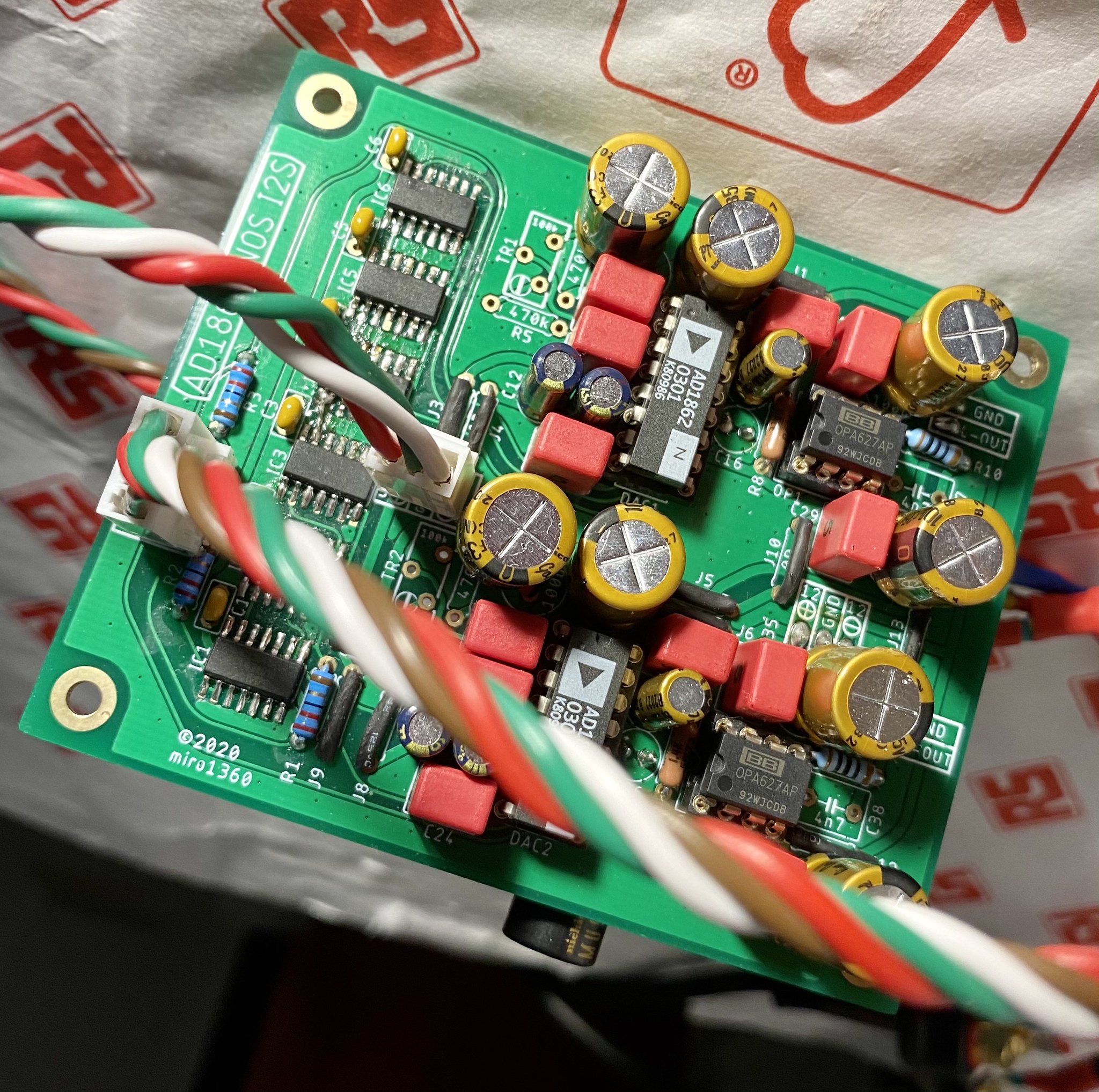
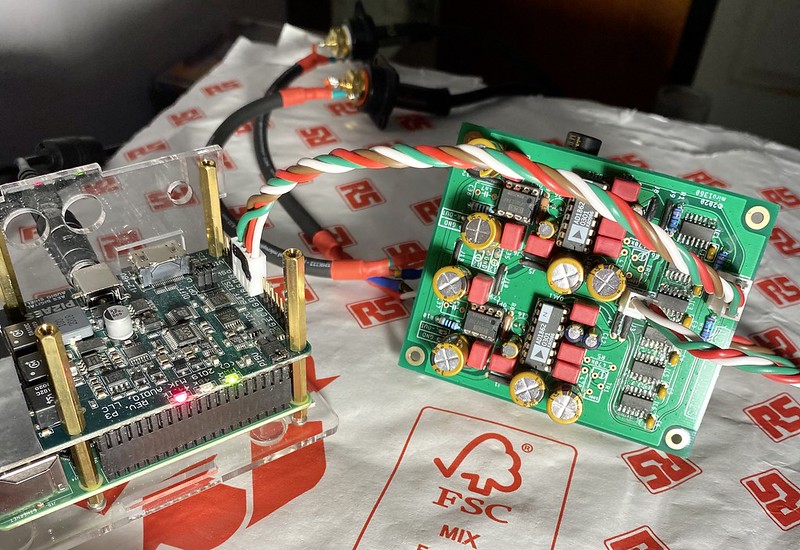
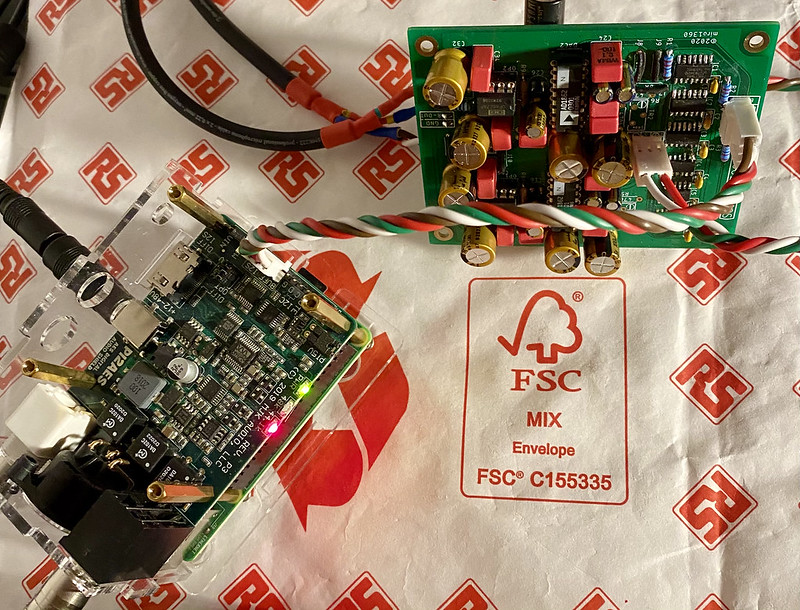
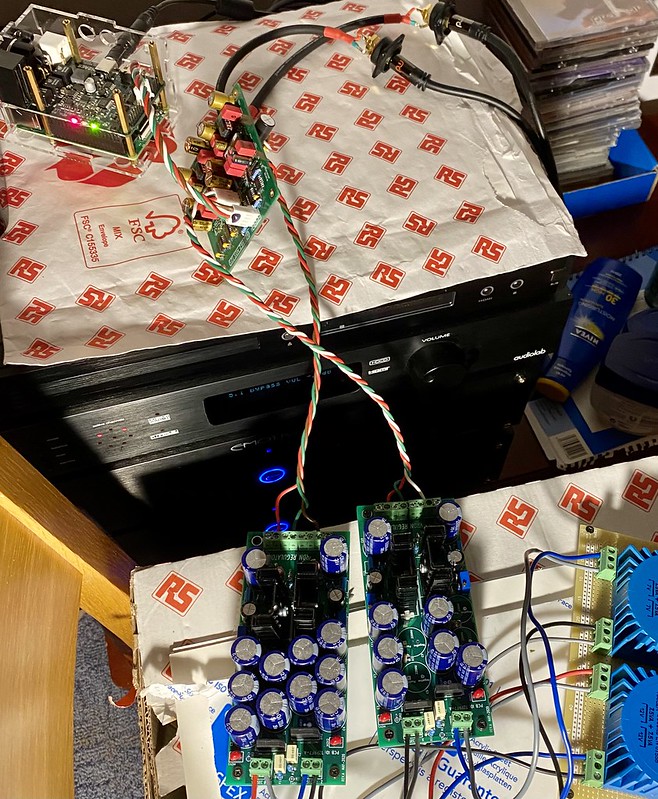
Completed DAC and connected to I2S output from PI2AES audio shield from PI2Design. Power supply are modified VRDN for 5 V and 12 V.
Woking well and I’m planning to put all of these together with a active volume control into a nice case.




Last edited:
Active volume control
I’m looking for a decent active volume control to add to DAC.
Looking at Doug Self Preamp from Linear Audio, and I want to omit tone control but just use active volume control part.
Can OPA627 buffer in DAC drive the active volume circuit directly or should I use another buffer in between.
Thanks
I’m looking for a decent active volume control to add to DAC.
Looking at Doug Self Preamp from Linear Audio, and I want to omit tone control but just use active volume control part.
Can OPA627 buffer in DAC drive the active volume circuit directly or should I use another buffer in between.
Thanks
I did an experiment this evening. A while back I bought a few cheap valve stages from Aliexpress. One is in a postmans bag somewhere, but the other one landed here a while back. I originally bought these to try a lampizator type output stage on a CD player, but thought why not at least try it on this DAC. The module is like the one in the pic - its a 3a5 twin triode DHT and the arrangement is as a paralleled triode. I think its the same as was found in the driver stage of some Chinese valve amps.
Anyway, it hums, and is microphonic as you'd expect, but with a bit of B+ filtering and arranging the filament supply I was able to get it down to a reasonable level. I think I would need CCS on the cathode and a regulated anode supply, along with a dedicated filament bias system to get it completely quiet, but its interesting to see how it sounds. I used a 300R IV resistor which probably breaks all sorts of rules. It sounds pretty good. Its not as dynamic as EUVL's current mirror but its pretty nice I gotta say, very sweet, clean, good bass response if a little softer than the best, and a pretty glorious midrange. It doesn't offend in any way.
Not bad for 25 quid (once you have the parts to make up the PSU for it). Not sure if I'd recommend it to anyone - I think if you were going to do this, there would probably be better options out there, but I had it sitting there, wasn't that big a deal to do it, and its interesting to hear what a different output stage sounds like.
fran
Cool.
I wwondered with its 1 mA if a apaired D3A in triode mode would not be the ideal candidate...
Though this tube became expensive and dunno where the good sources are in Europe.
.Maybe the less good E180F ? Anyway in term of details hard to beat an opa 1611/1612...But of course details are not all.
I have changed resistors for lm 317/337 to output 5V.
Original circuit was for 11 - 20V. Compared both De-Noiser circuit enabled and disabled for 5V and does not have any effect on audio output.
Original circuit was for 11 - 20V. Compared both De-Noiser circuit enabled and disabled for 5V and does not have any effect on audio output.
We have not to forgett what Miro said about the internal powersupply of the ad1862 🙂.
A really good dac chip that AD1862...
A really good dac chip that AD1862...
So it is basically running as a plain 317/337. Thanks for the clarification. What happens it it is tried to run with denoiser st 5v. Oscillation I assume.?
Cool.
I wwondered with its 1 mA if a apaired D3A in triode mode would not be the ideal candidate...
Though this tube became expensive and dunno where the good sources are in Europe.
.Maybe the less good E180F ? Anyway in term of details hard to beat an opa 1611/1612...But of course details are not all.
I can't comment on that - but I am continuing to work on the 3a5 stage ( there's a thread over in the tubes forum on it). So, I bought a pair of RCA 3a5 from langrex in the UK, they are definitely less microphonic and are quieter as well, although you can't hear the others from the listening chair even at high enough volume. I've been using batteries on the filament and that cured the last of the noise. So I've gone on now to order a set of coleman filament kits and the gurus over in tubes recommend that plus a few other changes. So in a week or two I hope to have some changes made.
The other stage arrived and I tried that out as well. It gave excellent results too, but I think the 3a5 has a bit more magic. If you search for "YJ preamp kit srpp 6n2" you'll see it. Its far easier to implement than the 3a5 and is dead quiet in operation. Definitely an option. A friend prefers the 6n2 stage to the 3a5 so there might be just personal preference in it.
So lots of options out there for output stages..... one of the great bonuses of this DAC layout. Thank you Miro!!
I can't comment on that - but I am continuing to work on the 3a5 stage ( there's a thread over in the tubes forum on it). So, I bought a pair of RCA 3a5 from langrex in the UK, they are definitely less microphonic and are quieter as well, although you can't hear the others from the listening chair even at high enough volume. I've been using batteries on the filament and that cured the last of the noise. So I've gone on now to order a set of coleman filament kits and the gurus over in tubes recommend that plus a few other changes. So in a week or two I hope to have some changes made.
The other stage arrived and I tried that out as well. It gave excellent results too, but I think the 3a5 has a bit more magic. If you search for "YJ preamp kit srpp 6n2" you'll see it. Its far easier to implement than the 3a5 and is dead quiet in operation. Definitely an option. A friend prefers the 6n2 stage to the 3a5 so there might be just personal preference in it.
So lots of options out there for output stages..... one of the great bonuses of this DAC layout. Thank you Miro!!
Thanks for the tip fran. I never worked with tubes for some reasons... but it's going viral.
I have designed a active volume control using lm4562 based on Self's preamp. Plan is to box DAC and Volume control along with raspberry pi into a compact streamer unit.😉
Any suggestions.
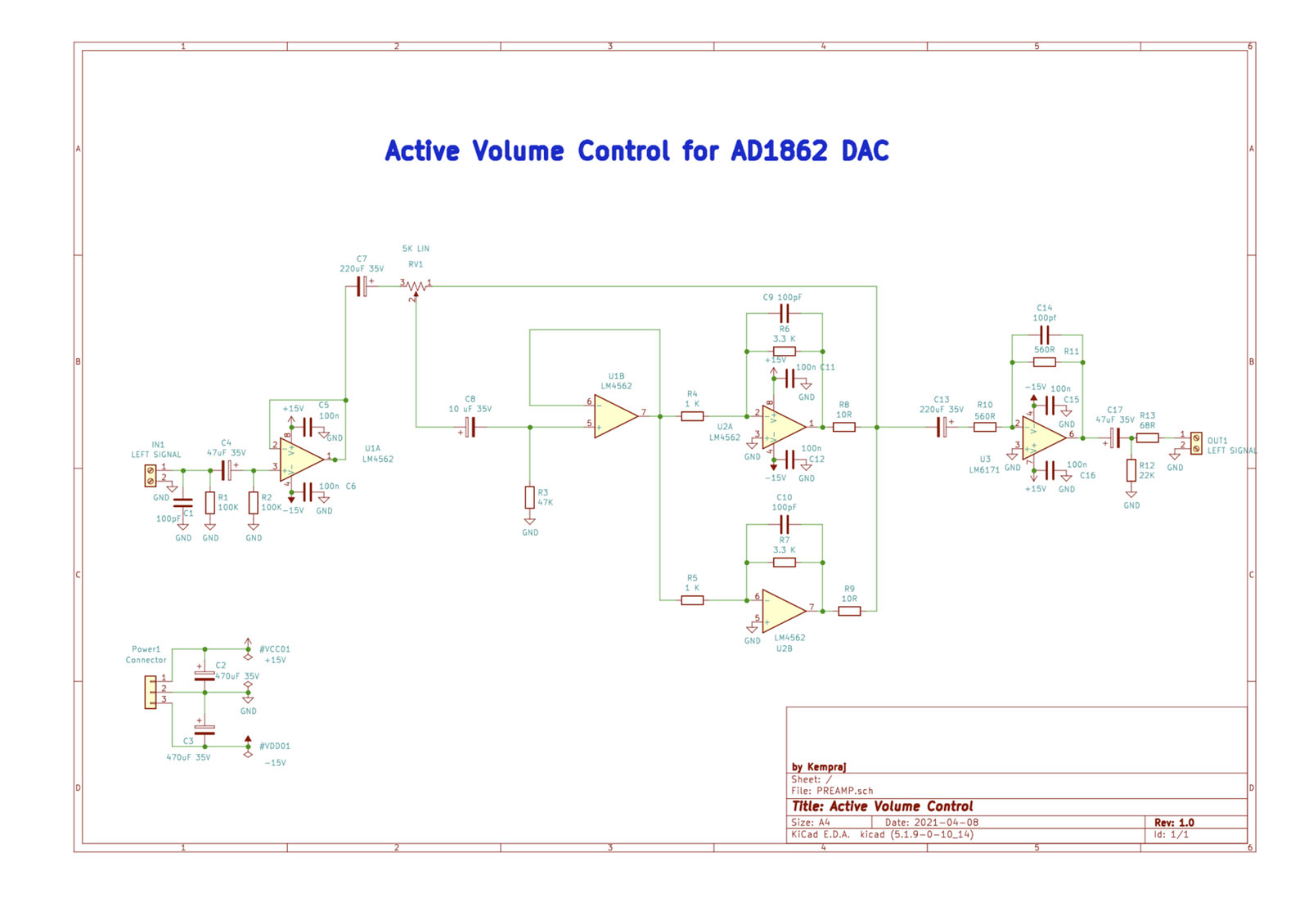
Any suggestions.

- Home
- Source & Line
- Digital Line Level
- DAC AD1862: Almost THT, I2S input, NOS, R-2R
